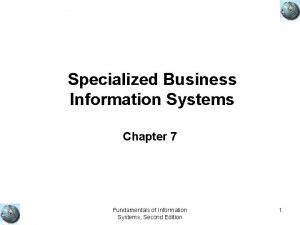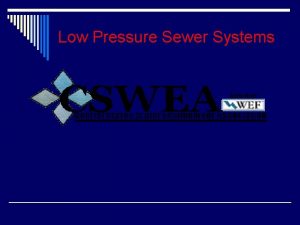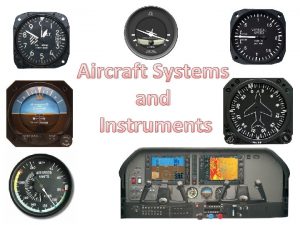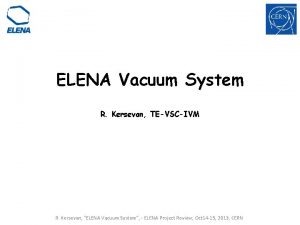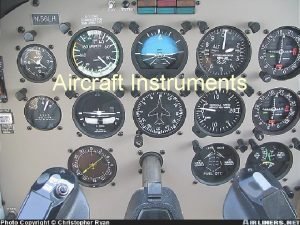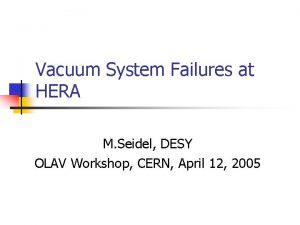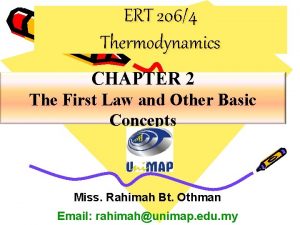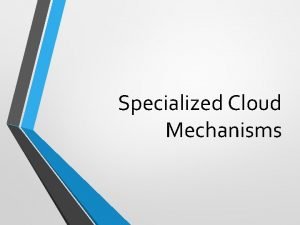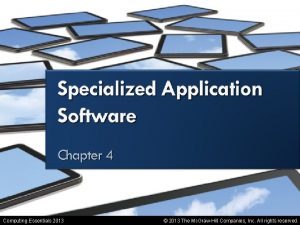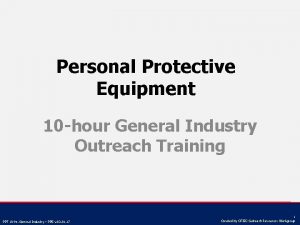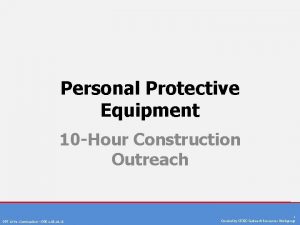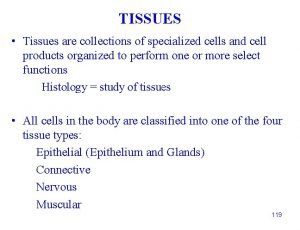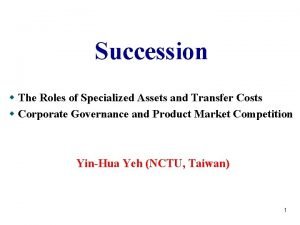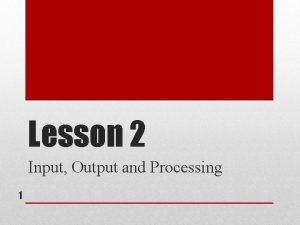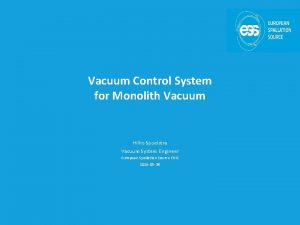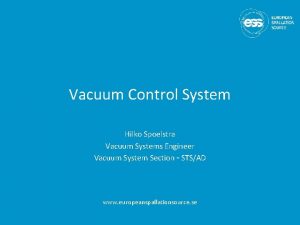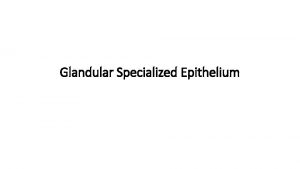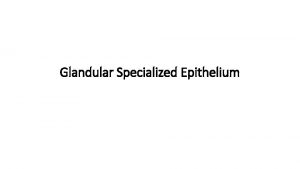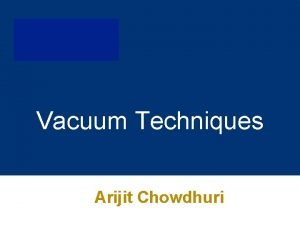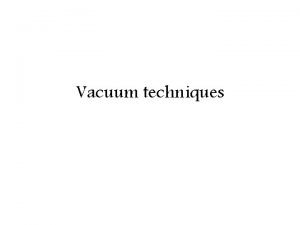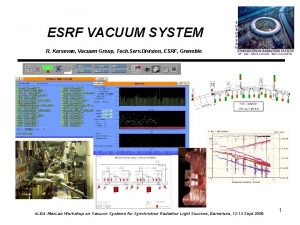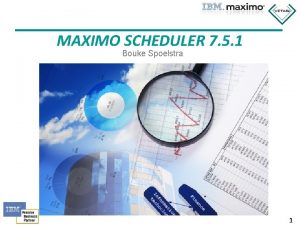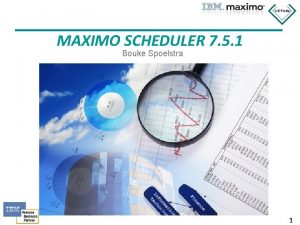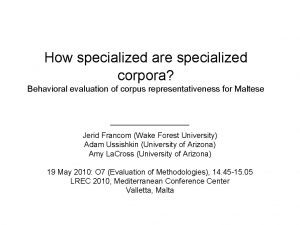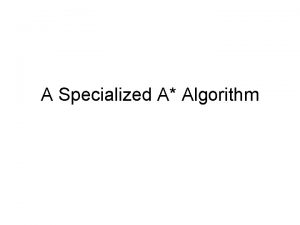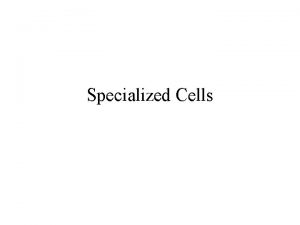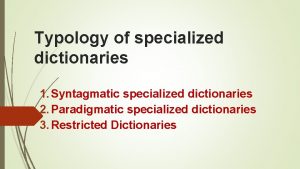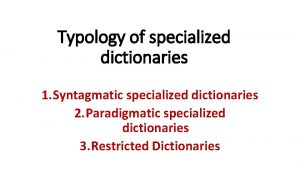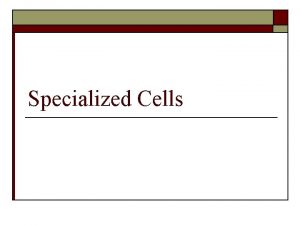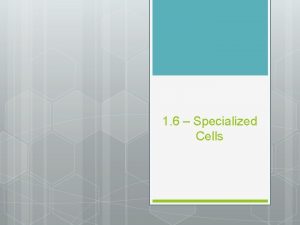Vacuum Control System Hilko Spoelstra Vacuum Group Specialized

























- Slides: 25

Vacuum Control System Hilko Spoelstra, Vacuum Group Specialized Technical Services / AD CDR MPSID and MPSVAC www. europeanspallationsource. se

Outline • • • Introduction Vacuum Control System Requirements Documents Vacuum interface to PLC based BIS (MPSVAC) Next steps Conclusion 2

ESS Vacuum Group Target Normal Conducting LINAC Super Conducting LINAC The ESS organization charges the ESS Vacuum Group (VG) with the responsibility for all ESS vacuum systems including not only the Accelerator, but also Instruments and Neutron Beam Lines and the Target. The main task of the ESS VG is to support the in kind contributions on the vacuum system and the integrated vacuum design of the ESS complex. Neutron Beam lines 3

LINAC Vacuum System Source LEBT RFQ MEBT DTL Spokes Med. β High β HEBT Terminology: (Vacuum) Section: LEBT, RFQ, MEBT, Spk, etc. Vacuum Sector: The volume/part between two Sector Gate Valves 4

Vacuum equipment summary for the accelerator • Standardization of vacuum equipment through a Framework Agreement (FA) • Single suppliers for each type of equipment (exception for gauges in the SCL) • Framework agreements even applicable for some of our in-kind partners. • The Gate Valves are the key point for this presentation 5

Vacuum Control System • Complete in-house design for control racks and control logic – Vacuum Group - > Hardware and Electric design (EPLAN) – Integrated Control System Group -> PLC and EPICS IOC programming • Common approach for all vacuum systems: Accelerator, Target and Neutron Instruments Epics Domain ICS team responsibility Vacuum group responsibility 6

Vacuum Control System Overview IOC Control Rack IPC Serial to Ethernet Server PLC Real Time I/O (Moxa Boxes) Valve Interface Primary Pump Controller Turbo Pump Controller Ion Pump Controller Fast Gate Valve Controller Gauge Controller Mass Flow Controller Tunnel Network Communication Digital I/O Analog Out Serial Communication Residual Gas Analizer 7

Controllers for pumps and gauges • The vacuum controllers themselves are the “brain” of the system. Internal protection circuits are always active. • Programmable threshold/interlock signals within the controllers are used for process control and interlocking. • Analog outputs representing the pressure are used for archiving. • RS 232 serial communication is used for visualizing parameters on the OPI, archiving and setting up the vacuum controllers remotely. 8

Vacuum Control, PLCs Interlock PLC VBP Process PLC 9

Vacuum Sector Valves Interlocks Machine Protection & Beam Permit PLC & Distributed IO: – Allows the centralization of the interlocks signals. – Flexibility on : - Selection of the Interlock’s trigger. - “Voting Plan” can be done case by case. - Valve(s) to be closed in case of interlocks. - Evolution & Modification. – Reduce cabling work (No Inter-section cabling = No Inter-racks cabling). 10

Vacuum Operation Data Acquisition of Analog values Real Time AI - Less critical signals Read out through RS 232 2 -3 Hz sample frequency No Time stamping - Critical systems Gauges on RF Couplers 1 k. Hz sample frequency Time stamping to ESS master clock 11

MPS – Interfaces Requirements Through multiple workshops and use cases between the MPS group and the Vacuum group, a set of requirements has been created for the interface between the Vacuum Control System and the Machine Protection System. – Concept and Scope for Machine Protection of Vacuum (Valves) (ESS-0188870) – Machine Protection Requirements on Vacuum Valves (ESS-0288079) – Machine Protection Requirements on MPSVAC (ESS-0288082) – Machine Protection Requirements on PBVI (ESS-0288083) – Machine Protection and PBVI Interface Control Document (ESS-0288085) – Machine Protection Analysis Document for Vacuum (ESS-0260440) – Machine Protection and Vacuum Valves Interface Control Document (ESS-0100091) 12

Requirements Main requirements: § § PBVI = Proton Beam Vacuum Interlock PLC VBP = Vacuum Beam Permit SGV = Sector Gate Valve MPSVAC = Machine Protection System PLC interfacing with Vacuum 13

Beam Permit • • The Linac has a total of 109 vacuum gate valves that can intercept the beam (109 Vacuum Sectors). One Beam Permit / Vacuum Sector The Vacuum Interlock PLC activates a Vacuum Beam Permit for a sector only if the Sector Gate Valve for that sector has received the command to open and if the Sector Gate Valve is in the open position (read by both position switches). Each Vacuum Beam Permit is hard wired to the MPSVAC PLC IO 14

Gate Valves • Gate valves: – Are used to separate two vacuum sectors. – Have relatively slow response times (0, 9 < t <15 s. ) and have therefor an interface with the PLC-based BIS. – Have a pneumatic actuator with 24 Vdc solenoid valve. – Have double pair of positions switches (MPS-REQ-VAC-1) – Through the standardisation and framework agreement ESS uses Series 8, Series 10 and Series 48 gate valves from VAT. (sizes from DN 40 – DN 250). 15

Fast Valves • 4 Fast Valves installed in the LINAC – 1 on each extremity of the Super Conducting Linac – 1 in the A 2 T prior to the shield wall – 1 in the Dmp. L • Series 75 + 77 from VAT • Due to fast closing times (< 15 ms. ) Fast Valves are connected to the FBIS and out of the scope of this CDR. 16

Opening of a Sector Gate Valve • No automatic opening of the gate valves. • Can only opened by an operator if at least one of the input criteria on each side of the gate valves is met. (input criteria is by default the threshold relays from a gauge or pump controller) OPEN Cmd Vacuum Interlock PLC Beam Permit “ 1” 17

Automatic closure of a Sector Gate Valve Automatic closure of the sector gate valves is triggered when both input criteria on at least one side of the gate valve is failing. Vacuum Interlock PLC Beam Permit “ 0” 18

Electrical Diagram Gate Valve 19

Electrical Overview, Beam Permit MPS-REQ-PBVI-1 MPS-REQ-PBVI-2 MPS-REQ-PBVI-3 MPS-REQ-PBVI-4 20

Failure Modes for Gate Valves Failure Gate Valve Position Switches Activated Vacuum Beam Permit Compressed air loss in open position Compressed air loss in closed position Compressed air loss during transition Control power fail in open position Undefined No switches activated, transition mode Closed position activated NOK Gate valve closes No switches activated, transition mode Closed posion activated No change in position Closed position activated NOK Gate valve closes Closed posion activated NOK No change in position No switches activated, transition mode NOK Control power fail in closed position Control power fail during transition (either way) Position switch power fail (transition, open or closed) No change in position Undefined NOK 21

Beam Destination and Vacuum Sectors • ESS LINAC has 8 beam destinations. • Vacuum Interlock PLC does not care about the beam destination. • Vacuum Interlock PLC creates an Beam Permit for each vacuum sector which is “OK” if the command is given to open the Sector Gate Valve and if the Sector Gate Valve is in the open-position. • Beam destination logic is handled by the MPSVAC PLC system. 22

Next steps… • Necessary control logic has been implemented and commissioned in the Vacuum Interlock PLC for the LEBT section to satisfy the interface requirements. This will be the base for the complete LINAC. • Hardware is installed in the LEBT vacuum control rack to interface with the MPSVAC PLC system to fulfil all requirements. • The integration of the Vacuum Interlock System (Beam Permit) and the MPSVAC systems has to be commissioned for the LEBT. • A procedure for commissioning and periodic tests of the Vacuum Beam Permit and the Gate Valve has been discussed but control functionality has not been implemented yet. The system will be EPICS based. 23

Conclusion • The ESS Vacuum Control System is designed in-house by the Vacuum Group and the Integrated Control System Group. • Through workshops and use cases the MPS group and the Vacuum group have created a set of requirements. • The requirements are addressed by implementing: • Sector gate valves with double position switches and special interface boxes to interface both the Vacuum Interlock System and the MPSVAC PLC System. • Interlock PLC system with logic for the Vacuum Beam Permit. • Hardware installed in the vacuum control racks to interface the Vacuum Beam Permit with the MPSVAC. • Next steps: • Commissioning of the integration of the Vacuum Beam Permit signals and Sector Gate Valve signals to MPSVAC as a base for the complete LINAC. • Integration of a test sequence for periodic test of the Sector Gate Valves and Vacuum Beam Permits. 24

Questions? 25
 Specialised business information systems
Specialised business information systems Low pressure sewer system design
Low pressure sewer system design Atomatoflames
Atomatoflames Vacuum system
Vacuum system Attitude indicator errors
Attitude indicator errors Vacuum system failure
Vacuum system failure Control mass system
Control mass system Special connective tissue
Special connective tissue Function of stems
Function of stems Enteral parenteral beslenme
Enteral parenteral beslenme Pay-per-use monitor
Pay-per-use monitor Specialized cloud architecture
Specialized cloud architecture Specialized applications examples
Specialized applications examples Specialized jobs in ancient egypt
Specialized jobs in ancient egypt Structure anatomy and physiology in agriculture
Structure anatomy and physiology in agriculture Ppe equipment and their uses
Ppe equipment and their uses Who is responsible for providing specialized work footwear?
Who is responsible for providing specialized work footwear? Direct distribution channel example
Direct distribution channel example Channelparticipants
Channelparticipants Rudimentary movement phase
Rudimentary movement phase Tdsb specialized programs
Tdsb specialized programs Collection of specialized cells and cell products
Collection of specialized cells and cell products Specialized assets
Specialized assets Mist chamber ppt
Mist chamber ppt Dr.sadaf specialized hospital
Dr.sadaf specialized hospital Standard input device
Standard input device
